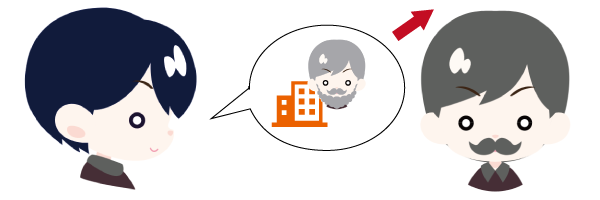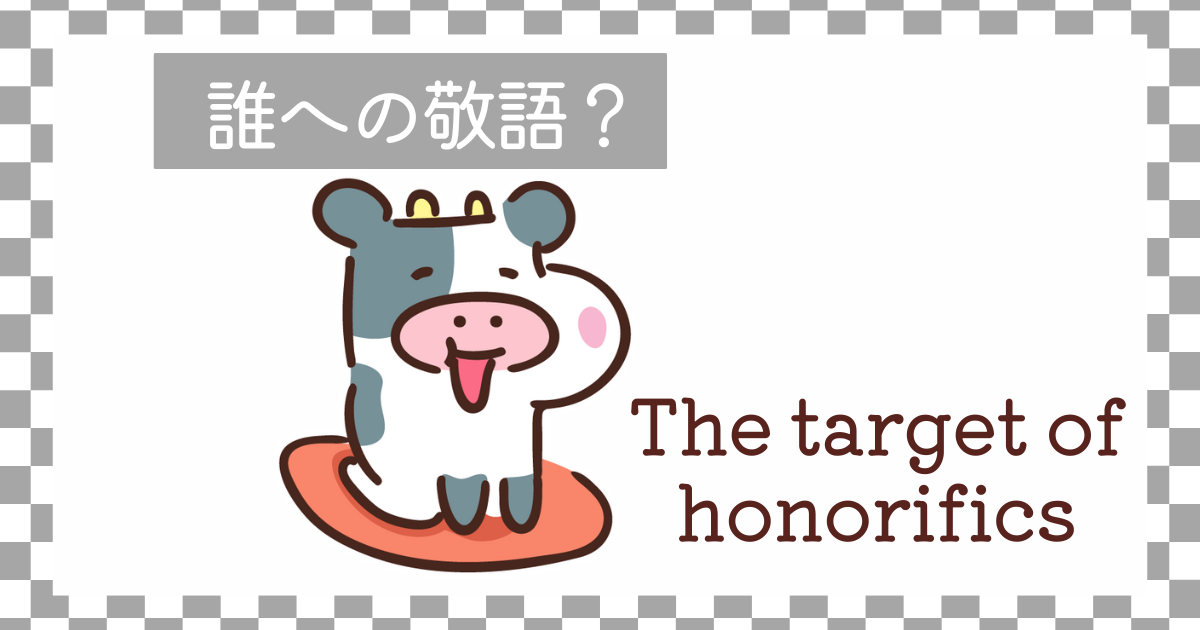
お客様には明日社長の山本が( )とお伝えください
Please tell the customer that Yamamoto CEO will visit tomorrow.
①いらっしゃる?
②参る?
③行く?

全部行くの意味ですよね。
All of them mean visit, right?
社長は偉い人だから①?
The CEO is in a high position, so ①?

おしい!正解は②
Close! The answer is ②
誰に敬意を払っているかに注目です。
Pay attention to whom you show respect.
敬語は3つの視点で考える
日本語の敬語には、謙譲語、尊敬語、丁寧語があると学びました。日本語の敬語について考える時は、話し手、聞き手、話の中で焦点が当てられている人(動作主)の立場を考えます。
謙譲語…動作主を低める
尊敬語…動作主を高める
丁寧語…聞き手に敬意を示す
※今回は日本語学習者用にシンプルに分類分けしています

自分、課長、社長の3人の関係性を踏まえて考えてみましょう
Consider the 3 positions
We’ve learned humble form(kenjou-go), honorific form(sonkei-go), and polite form(teinei-go) to show respect for others. When we think about Japanese honorifics, we need to consider the position of the speaker, the listener, and the person who is addressed (the agent).
humble form(kenjo-go)…humble the agent
honorific form(sonkei-go)…honor the agent
polite form(teinei-go)…honor the listener

Let’s consider this from the positions of myself, the chief, and the president.
謙譲語
謙譲語は動作主を聞き手より低めます。
行くの謙譲語「参る」を例にして考えましょう

社長、私がお迎えに参ります。
話し手:私、動作主:私、聞き手:社長

社長、課長がお迎えに参ります。
話し手:私、動作主:課長、聞き手:社長
動作主は課長であれ自分であれ、社長より立場が低いので謙譲語「参る」を使います。
humble form
Humble form makes the agent lower than the listener. Consider Humble form “参る” (to go).

I:Shacho, watashi ga omukae ni mairi masu.
(Boss, I will pick you up.)

I:Shacho, kacho ga omukae ni mairi masu.
(Boss, the chief will pick you up.)
Both the chief and I are in positions lower than the president, so we use the humble form “参る”.
尊敬語
尊敬語は動作主を話し手より高めます。
来るの尊敬語「見える」を例にして考えましょう。

課長、社長がお見えです。
話し手:自分、動作主:社長、聞き手:課長

鶴太郎、社長がお見えだ。
話し手:課長、動作主:社長、聞き手:自分
動作主である社長を、話し手である課長や自分より高めます。
honorific form
Honorific form makes the agent higher than the speaker. Consider honorific form “見える”(to come).

I:Kacho, shacho ga omie desu.
(Chief, boss came.)

Chief:Tsurutaro, shacho ga omie da.
(Tsurutaro, boss came.)
Elevates the president, who is the agent, above the chief and me, who are the speakers.
丁寧語
丁寧語は話し手から聞き手に対しての敬意を表します。目上の人だけでなく、見知らぬ人や初対面の人に対しても使います。よく使われる丁寧語に「です」「ます」があります。

課長、社長がお見えです。
話し手:自分、聞き手:課長

鶴太郎、社長がお見えだ。
話し手:課長、聞き手:自分
自分→課長へ敬意を示すために「です」を付けますが、基本課長→自分には使わないので、文末が普通形となります。
polite form
Polite form is used to show respect from the speaker to the listener. Not only superior person, but also stranger or new person. We often use it as desu or masu.

I:Kacho, shacho ga omie desu.
(Chief, boss came.)

Chief:Tsurutaro, shacho ga omie da.
(Tsurutaro, boss came.)
I add “desu” to show respect to the chief, but superiors don’t need to show respect to me, so the word of the chief ends in plain form.
覚えておきたい敬語フレーズ
とはいえ、話す時に原理を考えながら言葉を選ぶ余裕はありません。日本人あっても、使いながら敬語に慣れていきます。
ここで頻繁に使われる敬語を使った文章を紹介します。
○○と申します。
自己紹介をするときに使います。
お越しいただきありがとうございます。
来てくれたことへの感謝を伝える
伺っております。
事前に聞いているの意味。
いかがですか?
どうですか?の丁寧な表現。
少々お待ちいただけますか?
少し待ってもらうことをお願いする
失礼いたします。
その場に入るとき、去るとき、意見を述べる時など、目上の人に簡単に断りを入れる時に使う。
気を付けてお帰りください。
帰りの安全を願う表現。
丁寧な文章やメールを書くことからはじめてもいいかもしれませんね。
Everyday honorific phrases
However, when speaking, there is no room to think about the logic. Even native Japanese become accustomed to honorifics through usage.
Here are some phrases using honorific language that is frequently used here.
○○ to moushimasu.
Use to introduce yourself.
Okoshi itadaki arigatougozaimasu.
To express my gratitude for his visit
Ukagatte orimasu.
The meaning of having heard beforehand.
Ikaga desuka?
Polite expression of “How about it?, How do you think?”
Shoushou omachi itadakemasuka?
Asking to wait a moment politely.
Shitsurei itashimasu.
To ask permission briefly from a superior when entering or leaving the place, or when expressing an opinion, etc.
Kiwotukete okaeri kudasai.
An expression wishing for a safe return.
You might start by writing polite sentences or emails using honorifics.




コメント